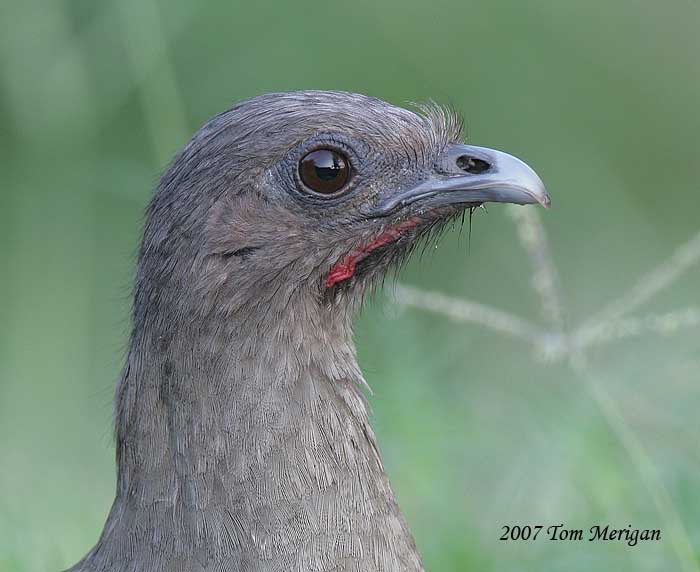
Plain Chachalaca
Ortalis Vetula
Galliforme Order – Cracidae Family
BIOMETRICS:
Length: 55 cm
Wingspan: 66 cm
Weight: 300-680 gr
DESCRIPTION:
Plan Chachalaca adult has dark grey bare skin around eye. It has grey head, slightly crested. We can see a small area of bare red skin in male throat in breeding plumage.

Out of breeding period, this area is greyish pink. This bare skin is bordered with short and soft feathers. Neck, breast and back are olive brown. Plain Chachalaca has brownish or yellowish belly. Undertail coverts are dusky cinnamon, but above, long tail is grey with green sheen, and pale area at the tip.
Bill is thick and blackish. Eyes are dark amber. Short and strong legs are dark grey.
Both sexes are similar, but male may be larger than female.
Juvenile resembles adult, with sometimes dark streaks on back.
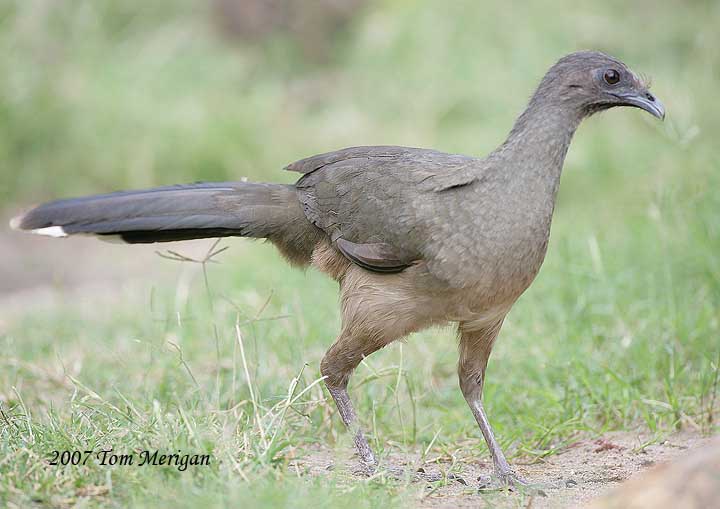
We can find 4 subspecies:
O.v. mccallii ; O.v. vetula ; O.v. pallidiventris ; O.v. deschauenseei.
They differ in size and plumage’s colour.
VOICE: SOUNDS BY XENO-CANTO
Plain Chachalaca’s call is a raucous repeated chattering, of three syllables “kuh-kuh-kuh” or “cha-cha-lac”, often uttered in groups at dawn and dusk.
We can also hear a low gruff “krrr-krrr-krrr…”. Calls are very loud and its alarm call resembles a hoarse bark of dog.
HABITAT:
Plain Chachalaca lives in brushy woodlands and forest edges, thickets and dense second growth, and riverside woodlands along which they often build their nests.
RANGE:
Plain Chachalaca is resident from southern Texas to north western Costa Rica and Nicaragua.
BEHAVIOUR:
Plain Chachalaca feeds low to high in trees, and sometimes on the ground. It may feed in strange positions, including upside down.
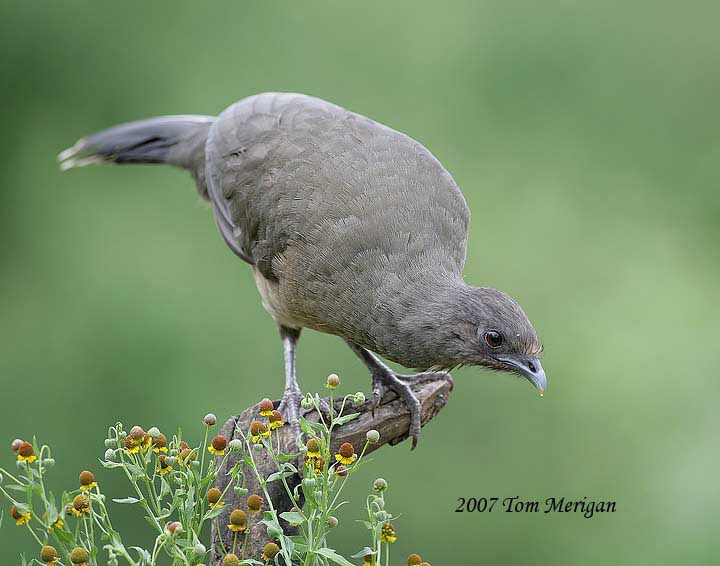
It is a noisy and gregarious bird. Typically in groups of 4 to 20 birds, they call loudly from treetop. They utter their raucous calls from high branches in trees, often at dawn and dusk. It is a bird difficult to see in foliage. They may be silent for long periods, but if only one begins to sing, the others sing too, and their chorus grows and spreads through the trees.
Plain Chachalaca walks along branches, feeding on berries and buds. It is a shy bird, often hidden in canopy.
During breeding season, male utters deeper and louder than other periods.
FLIGHT:
Plain Chachalaca often flies across roads and rivers, with swooping glides, with fanned tail and outstretched neck. It has rounded wings.
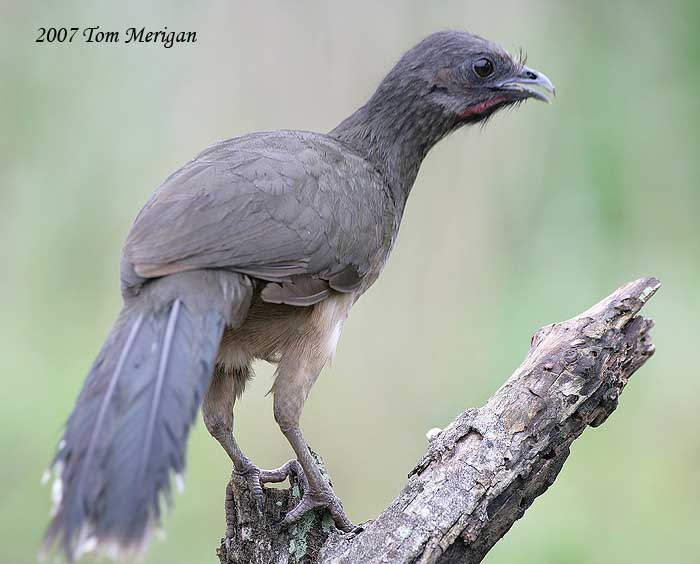
REPRODUCTION:
Plain Chachalaca may use old nests of other species. But usually, nest is located in a low branch of a tree, at about 3 to 30 feet above the ground, among the dense vegetation. The small nest is a rather flimsy structure made with sticks, and lined with mosses and leaves.
Female lays 3 to 4 dull white eggs. Incubation lasts about 22 to 27 days, by female. Chicks leave the nest shortly after hatching (one day) and follow the female. They can grasp and climb on branches, and they are able to fly short distances within the first week. They fledge at about 3 weeks of age. Both parents care for the young during some time after fledging.
This species produces only one clutch per year.
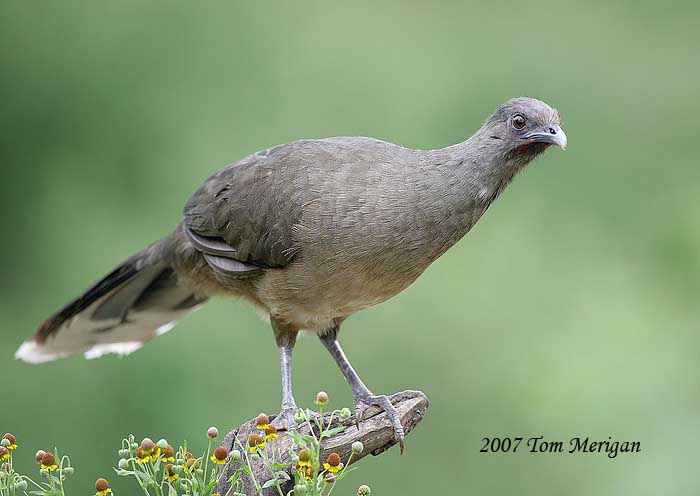
DIET:
Plain Chachalaca feeds on all kinds of fruits, leaves, buds, seeds and nuts, but also on insects and food from humans. During spring and summer, they feed on snails and caterpillars.
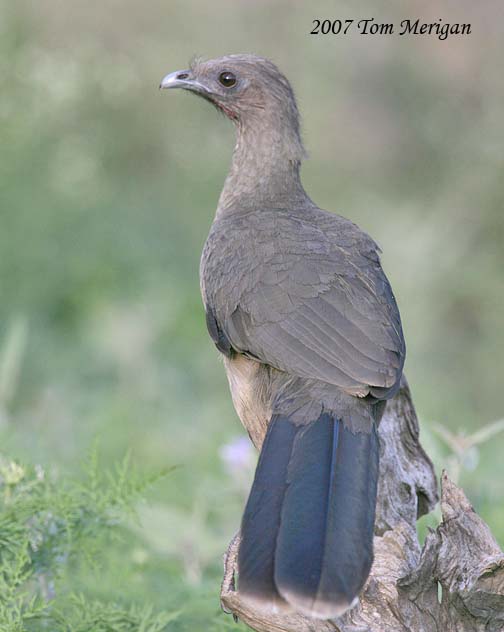
PROTECTION / THREATS / STATUS:
In the non-protected areas, Plain Chachalaca is a game bird. This species is threatened by habitat loss, especially in Central America where deforestation is important. Their favoured brushy habitat disappears, converted in cultivated areas.
However, this species is not globally threatened, being still common in most part of the range.
Fr: Ortalide chacamel
All : Braunflügelguan
Esp : Guacharaca Mexicana
Ital : Ciacialaca comune
Sd : Nordlig chachalaca
Photographs by Tom Merigan
His website :
Tom Meriganís Photo Galleries
Text by Nicole Bouglouan
Sources:
HANDBOOK OF THE BIRDS OF THE WORLD Vol 2 by Josep del Hoyo-Andrew Elliot-Jordi Sargatal - Lynx Edicions - ISBN: 8487334156
FIELD GUIDE TO THE BIRDS OF NORTH AMERICA by National Geographic Society - National Geographic Society - ISBN: 0792274512
All About Birds (Cornell Lab of Ornithology)
What Bird-The ultimate Bird Guide (Mitchell Waite)
Wikipedia (Wikipedia, The Free Encyclopedia)
Birds songs of the Yucatan Peninsula (Dan Mennil's)